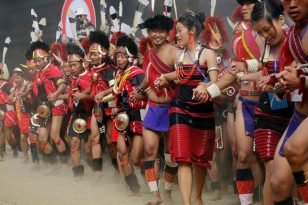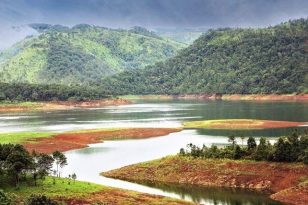| Tour Price | Land Only: £ 2748 per person twin sharing based on a group of 4 persons | |
| Flights | We can arrange to book flights for you through our partner travel agent or you can arrange your own flights and we will arrange for your transfer from the place where the tour starts | |
| Best time of visit | March-May and October | |
| No of days | 13 days | |
| Tour Dossier | Download Dossier | Booking Enquiry |
Overview
With 70% forest cover, Bhutan is covered in serene endless forests and here you will find some of the most beautiful and special birds. The vegetation includes dramatic mountain passes to sub- tropical valley forests in some of the most beautiful scenery. Some of the bird species spotted include Beautiful Nuthatch, Himalayan Cutia, Himalayan Monal, Satyr Tragopan, Blood Pheasant, Rufous-necked Hornbill, Ward’s Trogon and a whole host of other spectacular species.
In this tour you will be covering West and Central Bhutan that gives a fantastic overview of birding in Bhutan.
Destinations
Paro → Thimphu → Punakha → Trongsa
Detailed Itinerary
Arrive at Paro International Airport from Delhi, Calcutta, Kathmandu or Bangkok. Paro is situated in a beautiful valley – a fitting introduction to this charming kingdom. Your tour guide will meet you and take you to your hotel. This afternoon you can do some birding in the Paro valley. Overnight in Paro.
Accomodation: Olathang Resort or similar
In particular we shall be looking out for the beautiful Ibisbill, which breeds here amongst the gravel islands in the fast-flowing rivers, and the furtive Black-tailed Crake. Typical breeding birds of the area include River Lapwing, Oriental Turtle Dove, Eurasian Hoopoe, Black Bulbul, Grey-backed Shrike, Red-billed Chough, Large-billed Crow, Green-backed Tit, Brown Dipper, Rufous-breasted Accentor, Plumbeous and White-capped Water- Redstarts, Siberian Stonechat, Grey Bushchat, Blue Whistling Thrush, White Wagtail and Russet Sparrow, while lingering winter visitors are likely to include Green Sandpiper, Rosy Pipit, Hodgson’s Redstart and Black-throated Thrush.
Take an early morning trip up to the Chele La pass on the road to Haa for your first opportunity to view some spectacular Himalayan birds, not least the spectacular Himalayan Monal. Late afternoon drive along the Paro and Thimphu river valleys to Thimphu, Bhutan’s capital. Overnight in Thimphu.
Accomodation: Phuntsho Pelri or similar
During our visit we will have our first opportunity to find the attractive rainbow coloured Himalayan Monal, the Satyr Tragopan, Blood Pheasant and Kalij Pheasant and also see a good selection of high altitude species, most of which will become very familiar to us during our travels. Typical species here include Eurasian Sparrowhawk, Grey Nightjar, Yellow-billed Blue Magpie, Spotted (or Eurasian) Nutcracker, Long-tailed Minivet, Coal, Grey- crested and Rufous-fronted Tits, Black-faced Laughingthrush, White- browed Fulvetta, Rufous-vented Yuhina, Rufous-gorgeted Flycatcher, Buff-barred Warbler, Himalayan Bluetail, Blue-fronted Redstart, Long-tailed Thrush, White-collared Blackbird, Mrs Gould’s Sunbird, Olive-backed Pipit, the huge Collared Grosbeak, White-winged Grosbeak, and White-browed and Dark-rumpedRosefinches. With a bit of luck we will find some Altai Accentors lingering in their winter quarters while they wait for their breeding grounds in the far Tien Shan and Altai mountains to become more hospitable.
Another early morning start as you drive east, to the old capital, Punakha, via Dochu La pass at 3050 metres, where we will stop for a hot drink and enjoy spectacular panoramic views of the Eastern Himalaya ranges together with views of the extensive forests which will provide a mouth-watering introduction to the ornithological delights of these mountain ranges. Overnight in Punakha.
Accomodation: Zangto Pelri or similar
The star attraction is the stunning but secretive Satyr Tragopan. We will listen for their rather braying calls, and persistence may well be rewarded by views of a glowing red male stalking across a bamboo- choked hillside, with the drab female quietly feeding nearby. White- throated, Striated and Chestnut- crowned Laughingthrushes are likely to be prowling noisily through the undergrowth, while other species we may encounter include Darjeeling Woodpecker, Rufous Sibia, Hoary- throated Barwing, the lovely but restless Fire-tailed Myzornis, Stripe- throated Yuhina, Rufous-winged Fulvettas, Lemon-rumped and Ashy- throated Warblers, Whistler’s Warbler, Phylloscopus-like Yellow-browed Tit, Rusty-flanked Treecreeper, Green-tailed Sunbird, Red Crossbill, Dark-breasted Rosefinch and Red-headed Bullfinch.
Travel up the Mo Chu valley to an excellent area of forest where your birding will be concentrated. Overnight in Punakha.
Accomodation: Zangto Pelri or similar
We should find Great Cormorant, Pallas’s Fish Eagle, Crested Kingfisher and Slaty-backed Forktail. We will see a wide selection of species today, but in particular we will be looking out for the localized Yellow-vented Warbler, which is common in these mid-altitude forests and the delightful Spotted Elachura, which positively vibrates as it pours out its amazingly loud song from a low perch. If we are very fortunate we will find the very rare and little-known White-bellied Heron. Other birds we could well encounter include Crested Serpent Eagle, Kalij Pheasant, Oriental Cuckoo, Himalayan Swiftlet, House Swift, White-throated Kingfisher, Great and Golden-throated Barbets, Speckled Piculet, Grey-headed Woodpecker, Greater and Lesser Yellownapes, Maroon Oriole, Ashy and Hair-crested Drongos, Common Myna, Grey Treepie, Black-winged Cuckoo-Shrike, Mountain Bulbul, Ultramarine, Verditer and Grey-headed Canary Flycatchers, Small Niltava, Slaty-bellied Tesia, Blyth’s Leaf, Green-crowned and Grey- hooded Warblers, Black-throated Tit, Chestnut-bellied Nuthatch, Fire-breasted Flowerpecker and Black-throated Sunbird. There will also be an excellent selection of babblers which may include Rufous- capped Babbler, Rufous-chinned Laughingthrush, Red-tailed and Blue- winged Minlas, Whiskered Yuhina and Nepal Fulvetta. Along the river on the outskirts of town we will have another chance to find the splendid Ibisbill.
Early starts as we travel south towards Kamichu where there is thick forest and the climate warms up considerably allowing some fantastic birding opportunities. This location has been recommended by the Director of Bhutan’s Royal Society for the Protection of Nature – one of the leading experts on birding in Bhutan. Here you can see the White-Bellied Heron and the Kingfisher.
Overnight in Punakha.
Accomodation: Zangto Pelri or similar
Continue your journey eastwards along the main road that traverses the steep south-facing valleys of the region giving you spectacular views over the forested landscape. Much of your birding will be from the verges of the road as the traffic is light. Pass the impressive Wangdi Dzong along the way, sitting high above the river, before climbing up through lichen-festooned forest to the Pele La pass at 3300m.
Overnight in Trongsa.
Accomodation: Tashi Ninjay or similar
Birds we could see today include Himalayan Griffon, Hen Harrier, Chestnut-bellied Rock Thrush, Hume’s Bush Warbler (split from Yellowish-bellied), Grey-sided Bush Warbler and Fire-tailed Sunbird.
Turn southwards dropping into the deep valley of the Mangdechu river and then climb once more into the cool broad-leaved forests that surround Shemgang at 1950m. The Shemgang Road offers a cross-section of altitudes from Tingtibi at 650m where the road crosses the Mangdechu, right up to the highest point of the road at 1950m. Our birding will be concentrated at a lower altitude where you will have ready access to the specialities of these exciting forests.
Overnight for these 3 nights will be in a basic hotel at Tingtibi and at Panbang Jungle camp
In the lower altitude forests, we may see Pallas’s Fish Eagle, Mountain Imperial and perhaps Pin-tailed Green Pigeons, Emerald Dove, Banded Bay Cuckoo, Blue-bearded Bee-eater, Blue-throated Barbet, Rufous and Grey-capped Woodpeckers, Scarlet Minivet, Bar-winged Flycatcher Shrike, Large Woodshrike, White-throated, Black-crested and Ashy Bulbuls, Sultan Tit, Grey-throated Babbler, Nepal Fulvetta, Striated Yuhina, Lesser Necklaced and Rufous-chinned Laughingthrushes, Yellow-bellied Warbler, Streaked Spiderhunter and Crimson Sunbird. If we are fortunate we will also find the diminutive Rufous-faced Warbler. On the wetter forested slopes we shall be looking for Black Eagle, Barred Cuckoo-Dove, Wedge-tailed Green Pigeon, the secretive Hodgson’s Hawk-Cuckoo, White-throated Needletail, Rufous-necked Hornbill, Great Hornbill, Long-tailed Broadbill, Short-billed Minivet, Orange-bellied Leafbird, Yellow-cheeked Tit, White-browed Scimitar Babbler, Blue-winged Laughingthrush, the gorgeous Red-faced Liocichla, Silver-eared Mesia, Red-billed Leiothrix, Rusty-fronted Barwing, White-throated Fantail, Spotted Forktail, Common Green Magpie, Bronzed Drongo and Scarlet Finch. The jewel in the crown however is the enigmatic Beautiful Nuthatch,Pale-billed Parrotbill, White-hooded Babbler, and we shall naturally be making a special effort to locate this wonderful but difficult and localised species (we have a good chance in this fine area). If conditions are suitable we may be able to see some raptor migration moving northwards up the valley, perhaps including Oriental Honey Buzzards and Steppe Eagles. Primates occur in good numbers here too and you should see numerous troops of the rare and beautiful Golden Langur (discovered as late as 1956) along with the more proletarian Assamese Macaque.
After some final birding in the Shemgang area you will drive to Trongsa for the night (5 hours). Overnight in Trongsa.
Accomodation: Tashi Ninjay or similar
Along the route we shall check a roadside cliff festooned with the nests of Giant Rock Bees where Fork-tailed Swifts can be watched shooting in and out of their nest crevices. Here we shall hope to find the little-known Yellow-rumped Honeyguide as it sits quietly alongside the bees nests. As we drop into the drier and partly cultivated part of the valley, we should find Spotted Dove, Common Cuckoo, Long-tailed Shrike, Oriental Magpie Robin, Red-vented Bulbul, Striated Prinia, Blue-capped and Blue Rock Thrushes, Crested Bunting and, if we are lucky, a flock of Spot-winged Starlings. Continuing westwards to Trongsa, we shall pause on the bamboo-clad slopes of the Yutong La pass (3400m) where we have a final chance to look for such high altitude species as Alpine Accentor, White-browed Bush Robin, Great Parrotbill and even the furtive Fulvous Parrotbill.
Start the journey back west, with a drive of around 6 to 7 hours to reach the capital, Thimphu Overnight in Thimphu.
Accomodation: Phuntsho Pelri or similar
Early in the morning your guide will accompany you to the airport to see you off onto your flight and wish you TashiDelek (goodbye and good luck).
Inclusions & Additional Information
- All accommodation as mentioned above
- All meals
- Transportation
- English speaking Birding guide
- All sightseeing and birding as mentioned in itinerary
- Bhutan Royalty and all taxes included
- Bhutan Visa
- Flights
- Insurance
- Items of a personal nature
The accommodation included are all approved by Bhutan Tourism and equivalent to 3 star category hotels in the major cities and towns and basic accommodation facilities in the birding areas.
We organise Bhutanese visas for you. If you are coming in or out via India you will need an Indian visa and you need to apply for this before you leave home. If you are in transit through India and don’t leave the airport in theory you don’t need a visa, but you should check with your international airline that they will allow you to fly without one. Also note that you can’t check your luggage through all the way to Bhutan, so it is easier to manage this if you can go through immigration, collect your luggage and check in again from there. Don’t forget to get a multiple entry visa if necessary. If you are flying with Druk Air or Bhutan Airlines and have a touchdown en route you don’t need a visa for India/Nepal/Bangladesh, as you don’t get off the plane. For Kathmandu if you are stopping over you can get a transit visa on arrival for a short visit for US$5 or a 15-day visa for US$25 – you need to take a passport photo with you. If you come in to Bhutan overland you should be sure to get your exit stamp for India at the immigration office and not at the border.
The Bhutanese unit of currency is called the ngultrum and is pegged to the Indian rupee. Ngultrum are not available outside Bhutan and you cannot easily convert Ngultrum back to dollars. You can spend Indian Rupees in Bhutan and they are at par with Ngultrum. For spending money you should bring dollars if possible, as they are the easiest currency to change. You get better exchange rates for high value ($100) notes and also in some of the luxury hotels.Euros and sterling are also accepted throughout. Travellers’ cheques are not really worthwhile, as the exchange rates are poor. If you do want to buy souvenirs, credit cards can be used now in most places, although you may want to bring cash for market purchases where they won’t be. Visa is more readily accepted than MasterCard but there are places that you can use either. It is possible to use credit cards in a couple of ATM’s in Paro and Thimphu, but only to draw out local currency and not foreign currency. So bring all the US$ cash you think you might need as it is difficult to get hold of it in Bhutan.
We advise you may want to consider ensuring you are protected from typhoid, tetanus, diphtheria, polio, hepatitis and rabies. Japanese encephalitis is also sometimes recommended but check with your doctor or travel clinic once you know the time of year and the nature of your itinerary. In any event you should bring insect repellent, as there is a risk of encountering biting insects even if they don’t carry malaria.
For the best views if coming from Kathmandu it is worth sitting on the left of the plane as you fly into Paro (and on the right when you fly out). It is amazing how close you get to Everest and surrounding peaks! Unfortunately we are unable to influence seating in advance, so make sure you get to the airport in plenty of time to request this at check-in. Generally you should check in 2 hours before the flight. Luggage limits are 30kg per person in economy class and40kg per person in business class (in each case including carry-on bags), although they are generally fairly lax about excess weight and the excess baggage charge is not high.
Except in a few districts in the east of the country where there is a total ban on tobacco, smoking is still allowed in Bhutan but the sale of tobacco is prohibited. So if you need to smoke, bring your own and be prepared to be taxed on your supplies on entry to the country. There is also a recent law prohibiting smoking in offices and some public places.
Overseas mobiles and blackberries generally don’t work in Bhutan, although some report successful connections on the Vodafone network. If you want to you can purchase a SIM card for the B-mobile network and use this in your phone. Internet and wi-fi is also available in most of western Bhutan and in some other towns (including Bumthang), but it is patchy and intermittent with slow speeds.
As a guide, rainfall in Thimphu and Paro is about 25mm a month in January to March, rising to 50mm in April and May, 75mm in June, and then a whopping 355mm in July, 300mm in August, 125mm in September, back down to 75mm in October, 25 mm in November and 0 in December.






